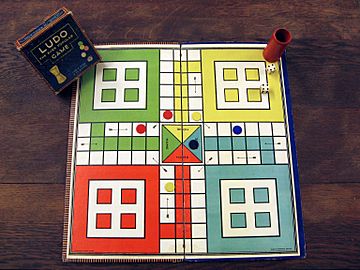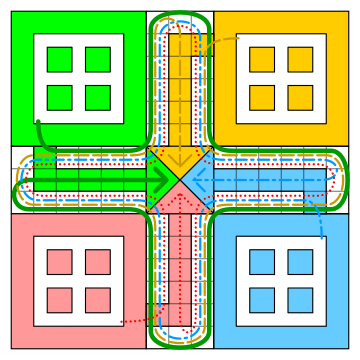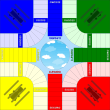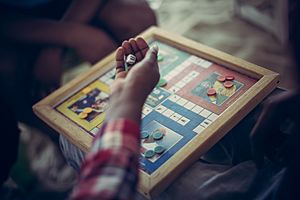Ludo (board game) facts for kids
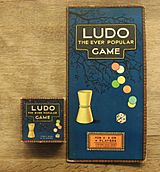
One of the first editions of Ludo
|
|
| Years active | Since c. 1896 |
|---|---|
| Genre(s) | Board game Race game Dice game |
| Players | 2–4 |
| Playing time | < 90 min |
| Random chance | High (dice rolling) |
| Skill(s) required | Strategy, tactics, counting, probability |
Ludo is a fun board game for two to four players. In this game, players race their four game pieces, called tokens, from a starting point to a finish line. They move their tokens based on the roll of a single die. Ludo comes from an older Indian game called Pachisi, but it's much simpler to play. Ludo and its different versions are popular in many countries around the world.
Contents
The Ludo Board
The Ludo board has special areas that are usually bright yellow, green, red, and blue. Each player gets a color and four tokens that match their color. The board is usually square. It has a cross shape in the middle where players move their tokens. Each arm of the cross has three columns of squares.
The middle columns usually have five colored squares. These are a player's home column. There's also a sixth colored square, not in the home column, which is a player's starting square. In the very center of the board is a large finishing square. This is often made of colored triangles that point to the finish line.
How to Play Ludo
Getting Started
Two, three, or four people can play Ludo. No one plays as a team. At the start of the game, each player's four tokens are in their yard. This is one of the large colored corner areas on the board.
To start playing, players need to get their tokens out of the yard. Once a token is out, players move it clockwise around the board. This path is called the game track. When a token reaches the square just before its home column, it moves up that column to the finishing square. The number you roll on the die decides how fast your tokens move. To get a token into the finishing square, you need to roll the exact number. The first player to get all their tokens to the finish wins the game! Other players can keep playing to see who finishes second, third, and fourth.
Playing the Game
To begin, each player rolls the die. The player with the highest roll goes first. Turns then go around the table in a clockwise direction.
To move a token from your yard onto its starting square, you must roll a 6. If you roll a 6, you can bring a token out. You also get an extra roll! If you don't have any tokens on the board and don't roll a 6, your turn ends.
Once you have tokens on the board, you must move one of them according to the number you rolled. You choose a token and move it forward that many squares. If your token lands on a square where an opponent's token is, you capture their token! Their token goes back to their yard. They can only get it back into play by rolling a 6. You cannot move past an opponent's token if it's blocking your way. If you can't make any move, your turn passes to the next player.
If you roll a 6, you get an extra "bonus" roll. If your bonus roll is also a 6, you get another bonus roll! But if your third roll in a row is also a 6, you cannot move any tokens. Your turn ends right away.
If your token lands on a square already taken by one of your own tokens, they form a "block." These two tokens move together as one. If your block lands on an opponent's block, you capture their whole block! Their tokens go back to their yard.
The squares in your home column are always safe. Opponents cannot enter them. In your home column, you cannot jump over your own tokens. You must roll the exact number needed to get each token into the home triangle.
Different Ways to Play Ludo
Ludo is known by many names and has different versions around the world.
Here are a few examples:
- Uckers: A British version.
- Pachisi: The original Indian game Ludo comes from.
- Fia: A Swedish version.
- Eile mit Weile (Haste makes Pace): A Swiss version.
- Cờ cá ngựa: A Vietnamese version.
Popular Variants
- Parchís is the Spanish version, and Parqués is played in Colombia. These often have special rules like "mandatory restart" or "stolen heaven."
- Mensch ärgere dich nicht (meaning "Mate, Don't Get Angry") is a very popular German game from 1914. It has similar names in many other European countries, like "Mens Erger Je Niet" in Dutch.
- Petits Chevaux (Little Cavalry) is a French version.
- Aeroplane chess is a Chinese game based on Ludo. It uses airplanes as tokens and has extra features like jumps and shortcuts.
Rule Differences
- In India, Ludo often uses two dice. Also, rolling a 1 on a die can let a token enter the game, just like a 6. So, if you roll a 1 and a 6, you can get a token out and move it six steps!
- In Pakistan, a version uses two dice and lets you move tokens backward. You can use the dice values separately or together to move one or two pieces forward or backward.
- Some house rules let players get their first piece out on any roll, or on a 1 or a 6, to start the game faster.
- Sometimes, if a token lands on the same space as another token of the same color, the moved token must go to the space before it.
- In some places, if you capture an opponent's token, you get an extra turn or bonus move.
- In Denmark, the board has special "globe" spaces that are safe. Your tokens cannot be captured there.
- In Vietnam, in "Cờ cá ngựa," a 1 roll is just as good as a 6 for getting a token out and getting an extra roll. Also, once a token reaches its home column, it needs an exact roll to move up each square. For example, you need a 1 to enter the first square, then a 2 for the second, and so on.
African Rules
In some parts of Africa, Ludo has unique rules:
- A "block" (two tokens together) can also block your own tokens behind it. Or, your own tokens might need an exact roll to land on the block.
- If two players sitting opposite each other are partners, they can swap numbers they roll!
- Some boards have four extra safety squares, like "castle" squares, where tokens are safe.
- If your token lands on a square with an opponent's token, their token goes back to their yard, but your token also goes back to your home square!
- A player might not be able to move their first token into the home column until they have captured at least one opponent's token.
- If you capture an opponent's token, you get a bonus roll. If you capture another token on that bonus roll, you get another bonus roll!
See also
 In Spanish: Ludo para niños
In Spanish: Ludo para niños


